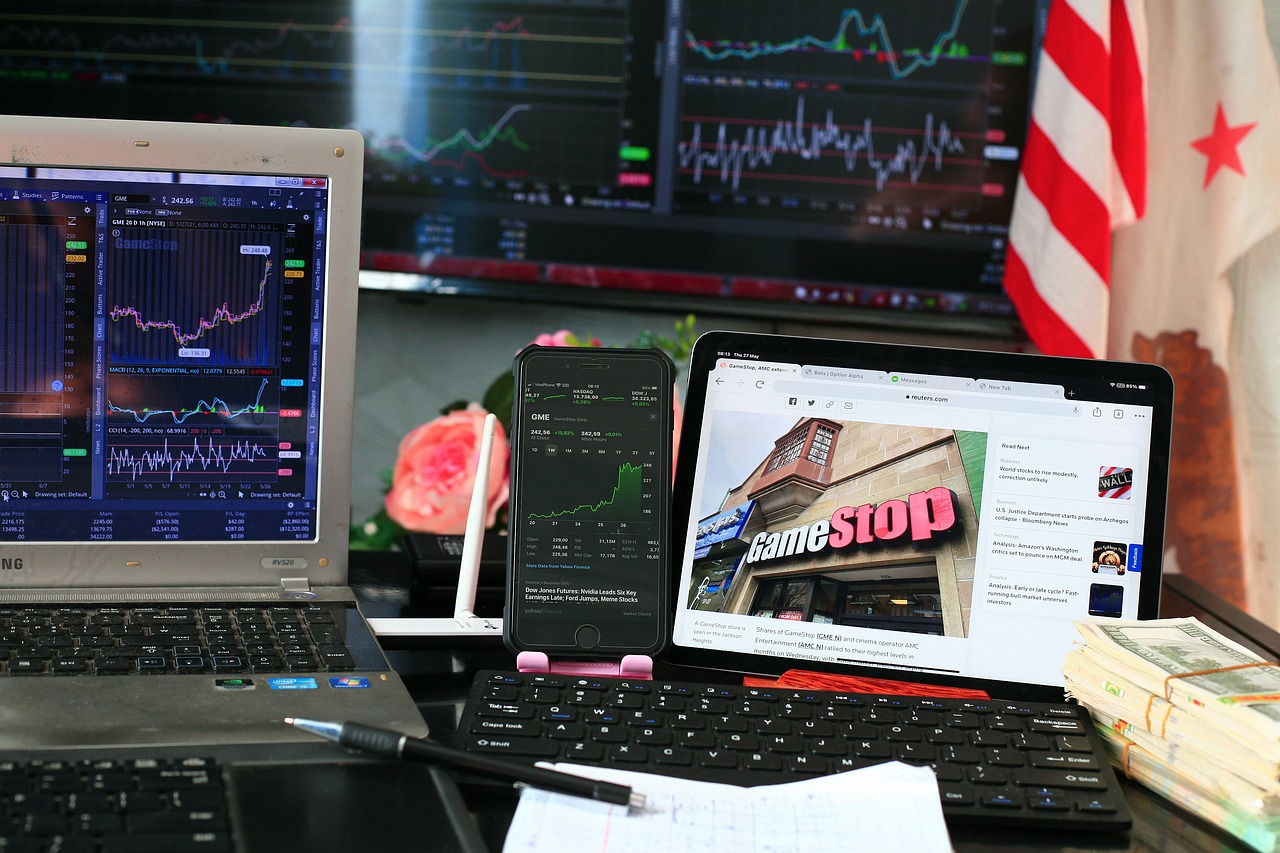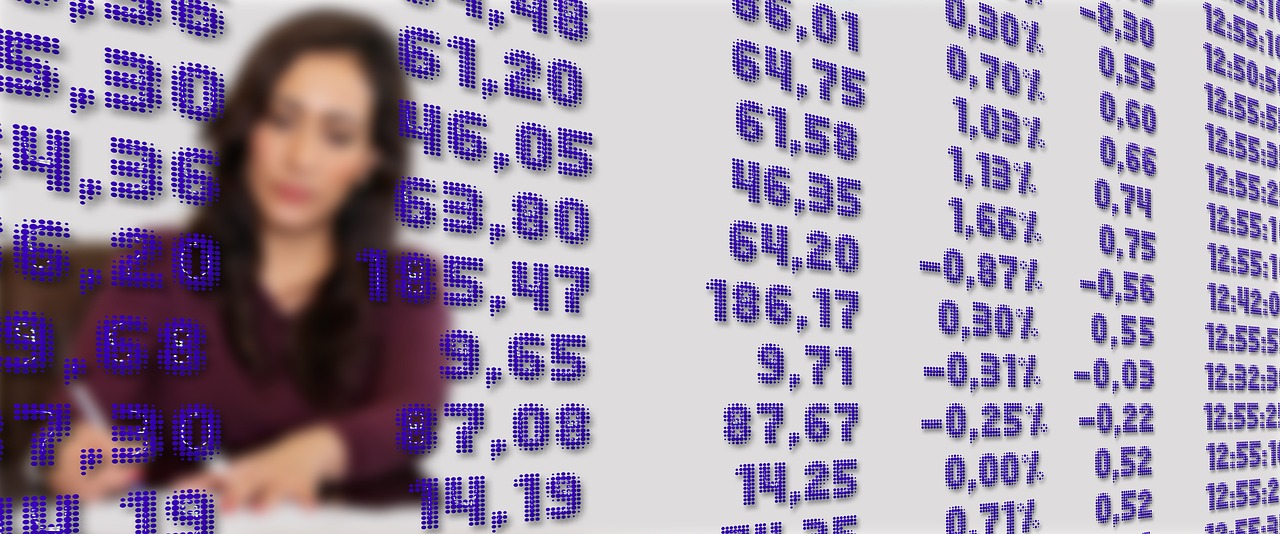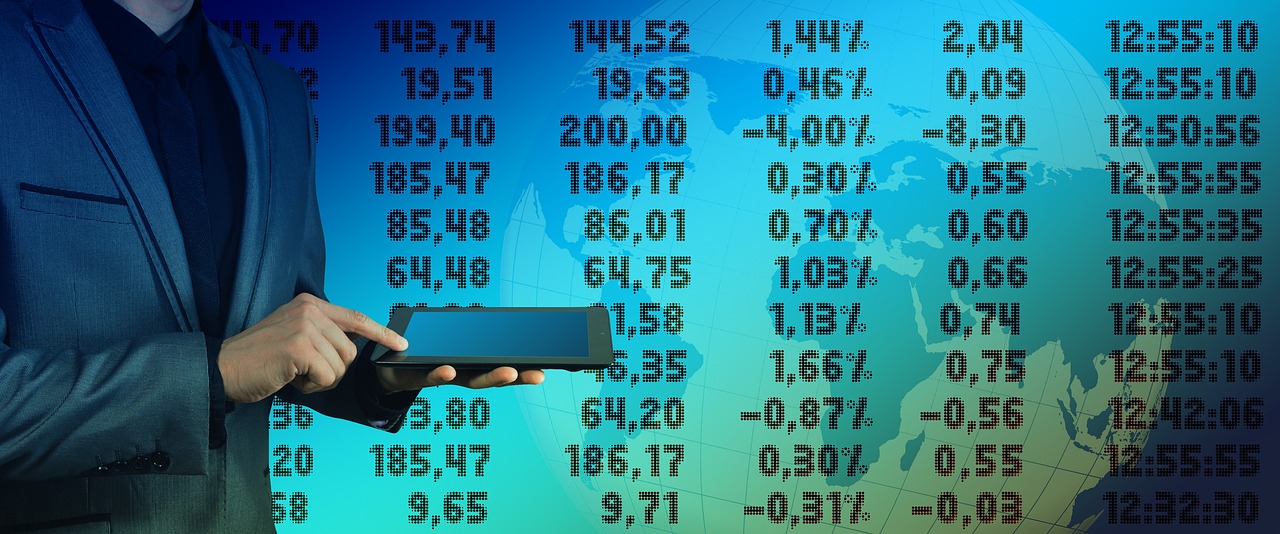How to Use Technical Indicators for Swing Trading
Welcome to the exciting world of swing trading! If you've ever found yourself wondering how to make sense of the chaotic dance of stock prices, you're not alone. Many traders face the daunting task of navigating the market's ups and downs, but fear not—technical indicators are here to help! These mathematical tools provide clarity and direction, guiding traders through the fog of uncertainty. In this article, we’ll explore how to effectively use these indicators to enhance your swing trading strategies, ultimately leading to more informed and confident trading decisions.
So, what exactly are these technical indicators? Think of them as your personal market detectives, analyzing price and volume data to uncover hidden trends, momentum shifts, and potential reversals. They serve as vital tools in your trading toolbox, helping you to make sense of the market's behavior. By understanding and applying these indicators, you can elevate your trading game and position yourself for success.
The beauty of swing trading lies in its flexibility; it allows you to capitalize on price movements over a few days to weeks. But to do this effectively, you need to be equipped with the right knowledge and tools. Technical indicators not only help you identify the current market conditions but also empower you to anticipate future movements. Imagine having a crystal ball that reveals potential entry and exit points—this is what technical indicators can do for you!
As we dive deeper, we will discuss various types of technical indicators, including trend indicators, momentum indicators, volatility indicators, and volume indicators. Each type serves a unique purpose, and understanding these differences can significantly enhance your trading strategies. By the end of this article, you will be equipped with the knowledge to implement these indicators in your swing trading approach, making you a more informed and confident trader.
Technical indicators are essential for swing traders looking to make informed decisions. They are derived from historical price and volume data, providing insights into market behavior. By analyzing these indicators, traders can identify trends, measure momentum, and spot potential reversals. This analytical approach is crucial for maximizing profits and minimizing risks in swing trading.
When it comes to technical indicators, there are several categories to consider. Each type plays a distinct role in market analysis:
- Trend Indicators: Help identify the direction of the market.
- Momentum Indicators: Measure the speed of price movements.
- Volatility Indicators: Assess market fluctuations.
- Volume Indicators: Analyze trading volume to confirm trends.
By understanding these categories, you can select the right indicators to inform your trading strategies effectively.
One of the most effective strategies in swing trading is to combine multiple technical indicators. This approach provides a comprehensive view of market conditions and helps confirm trading signals. For instance, using a trend indicator alongside a momentum indicator can enhance your ability to identify strong trading opportunities. Combining indicators reduces the risk of false signals and increases your confidence in your trading decisions.
Creating a successful trading strategy involves more than just selecting indicators. You need to establish clear entry and exit criteria and set rules for risk management. A well-defined strategy is like a roadmap, guiding you through the complexities of swing trading. It allows you to stay disciplined, even when emotions run high during market fluctuations.
Before diving into live trading, it's crucial to backtest your strategy using historical data. This process helps you evaluate the effectiveness of your indicators and identify any weaknesses in your approach. By simulating trades based on past data, you can refine your strategy and increase your chances of success in real-time trading.
1. What is a technical indicator?
A technical indicator is a mathematical calculation based on price and volume data that helps traders analyze market trends and make informed trading decisions.
2. How do I choose the right indicators for swing trading?
Choosing the right indicators involves understanding your trading style and the market conditions. Consider using a combination of trend, momentum, and volatility indicators to enhance your analysis.
3. Can I rely solely on technical indicators for trading?
While technical indicators are valuable tools, it's essential to consider other factors such as market news, economic indicators, and overall market sentiment when making trading decisions.
4. How often should I analyze technical indicators?
Regular analysis is key! Depending on your trading strategy, you may want to review indicators daily or even multiple times throughout the day to stay updated on market changes.
In conclusion, mastering technical indicators can significantly enhance your swing trading strategies. By understanding their application and combining them effectively, you can make more informed decisions and navigate the market with confidence. Happy trading!

Understanding Technical Indicators
Technical indicators are like the compass that guides traders through the often-turbulent waters of the financial markets. They are mathematical calculations derived from price and volume data, and they serve as essential tools for traders, especially those engaged in swing trading. By utilizing these indicators, traders can identify trends, assess momentum, and spot potential reversals in the market. But why are they so important? Imagine trying to navigate a vast ocean without any navigational tools; it would be incredibly challenging. Similarly, technical indicators help traders make informed decisions, enhancing their chances of success in the fast-paced trading environment.
At their core, technical indicators distill complex market data into actionable insights. They can be categorized into different types, each serving a unique purpose. For instance, some indicators focus on identifying the direction of the market, while others measure the speed of price movements or assess market volatility. Understanding how to interpret these signals can significantly improve your swing trading strategies. Whether you’re a novice or an experienced trader, grasping the fundamentals of these indicators is crucial.
To make the most out of technical indicators, it’s essential to recognize their strengths and limitations. While they can provide valuable insights, they are not foolproof. For example, a trend indicator might suggest a strong upward movement, but sudden market news can cause prices to plummet unexpectedly. Therefore, it’s vital to combine technical indicators with other forms of analysis and risk management strategies to create a well-rounded approach to trading.
In summary, understanding technical indicators is akin to learning the language of the market. They equip traders with the knowledge needed to interpret market signals effectively. By mastering these tools, you can enhance your trading strategies, make informed decisions, and ultimately increase your chances of achieving your financial goals.
- What are technical indicators? Technical indicators are mathematical calculations based on price and volume data that help traders analyze market trends and make informed decisions.
- How do I choose the right technical indicators for swing trading? Consider your trading style, market conditions, and the specific information you want to extract from the indicators. A combination of trend, momentum, and volatility indicators often works best.
- Can technical indicators guarantee success in trading? No, while they provide valuable insights, they are not foolproof. It's essential to use them in conjunction with other analysis methods and risk management strategies.

Types of Technical Indicators
When it comes to swing trading, understanding the available is crucial for any trader aiming to make informed decisions. Technical indicators can be broadly categorized into several types, each serving a unique purpose in analyzing market conditions. By leveraging these tools, traders can gain insights into price trends, momentum, volatility, and trading volume. This knowledge can be the difference between a successful trade and a missed opportunity.
Let's dive deeper into the main categories of technical indicators:
- Trend Indicators: These indicators help traders identify the direction of the market. They are essential for determining whether to enter or exit a trade based on the prevailing trend.
- Momentum Indicators: These indicators measure the speed of price movements and can signal potential reversals. They are particularly useful for identifying overbought or oversold conditions.
- Volatility Indicators: These indicators assess market fluctuations and help traders anticipate price breakouts. Managing risk is a key aspect of trading, and volatility indicators play a significant role in this area.
- Volume Indicators: These indicators analyze the strength of price movements by examining trading volume. They can confirm trends and provide insights into market sentiment.
By understanding these categories, traders can effectively combine different indicators to create a robust trading strategy. For instance, a trader might use a trend indicator in conjunction with a momentum indicator to confirm the strength of a price movement before entering a trade. This combination can provide a clearer picture of market dynamics and enhance decision-making.
Furthermore, each category of indicators has its own set of tools that traders can utilize:
| Indicator Type | Examples | Purpose |
|---|---|---|
| Trend Indicators | Moving Averages, ADX | Identify market direction and strength |
| Momentum Indicators | RSI, Stochastic Oscillator | Assess speed of price movements and potential reversals |
| Volatility Indicators | Bollinger Bands, ATR | Measure market fluctuations and potential breakouts |
| Volume Indicators | On-Balance Volume (OBV), Chaikin Money Flow | Analyze strength of price movements based on trading volume |
In summary, the are essential tools in a swing trader's toolkit. By mastering these indicators, traders can better navigate the complexities of the market and enhance their trading strategies. The key is to not only understand each indicator's function but also to know how to apply them effectively in different market scenarios.

Trend Indicators
When it comes to swing trading, understanding is like having a compass in the wilderness. They guide you through the often chaotic world of market fluctuations, helping you pinpoint the direction in which the market is heading. These indicators are essential for traders who want to capitalize on price movements over a short to medium timeframe. By identifying whether a market is trending upwards, downwards, or sideways, you can make more informed decisions about when to enter or exit trades.
One of the most popular trend indicators is the Moving Average. Moving averages smooth out price data by creating a constantly updated average price. They help filter out the "noise" of random price fluctuations, allowing traders to see the underlying trend more clearly. There are different types of moving averages, such as the Simple Moving Average (SMA) and the Exponential Moving Average (EMA).
| Type of Moving Average | Description |
|---|---|
| SMA | Averages the closing prices over a specific number of periods. |
| EMA | Gives more weight to recent prices, making it more responsive to new information. |
Another critical trend indicator is the Average Directional Index (ADX). Unlike moving averages, which tell you the direction of the trend, the ADX measures the strength of that trend. It ranges from 0 to 100, with values above 20 often indicating a strong trend. This information is invaluable for swing traders who want to ensure they are trading in the direction of a strong market movement.
To effectively use these indicators, consider combining them. For instance, you might use a moving average to determine the trend direction and the ADX to confirm the strength of that trend. This combination can help you make more confident trading decisions. But how do you know when to enter or exit a trade based on these indicators? Here are some guidelines:
- Entry Point: Look for price action above the moving average for a bullish signal or below for a bearish signal.
- Exit Point: Use the ADX value; if it drops below 20, it might indicate a trend reversal or weakening.
In summary, trend indicators are vital tools for swing traders. They not only help you identify the current market direction but also provide insights into the strength of that trend. By mastering these indicators, you can make more informed trading decisions, ultimately enhancing your chances of success in the market.
What are trend indicators?
Trend indicators are tools that help traders identify the direction and strength of price movements in the market.
How do I use moving averages in swing trading?
Moving averages can be used to determine entry and exit points by analyzing price action relative to the moving average line.
What does the ADX indicate?
The ADX measures the strength of a trend, helping traders decide whether to enter or exit trades based on market conditions.
Can I combine different trend indicators?
Yes, combining indicators like moving averages and ADX can provide a more comprehensive view of the market, leading to better trading decisions.

Moving Averages
Moving averages are one of the most popular and widely used technical indicators in the world of swing trading. They serve as a powerful tool to smooth out price data over a specified period, allowing traders to identify trends more clearly. Imagine trying to navigate through a dense fog; moving averages act like a lighthouse, guiding you through the murky waters of market fluctuations. By calculating the average price over a set number of periods, they help traders filter out the noise and focus on the underlying trend.
There are two main types of moving averages that traders often rely on: the Simple Moving Average (SMA) and the Exponential Moving Average (EMA). While both serve the same fundamental purpose, they differ in how they weigh the price data. The SMA gives equal weight to all prices in the period, making it slower to react to recent price changes. On the other hand, the EMA places more emphasis on the most recent prices, which can provide earlier signals for potential trend reversals. This responsiveness can be particularly beneficial for swing traders who need to act quickly.
To illustrate the difference between these two types of moving averages, consider the following table:
| Type of Moving Average | Calculation Method | Responsiveness |
|---|---|---|
| Simple Moving Average (SMA) | Average of prices over a set period | Slower to react |
| Exponential Moving Average (EMA) | Weighted average with more emphasis on recent prices | Faster to react |
When using moving averages in your swing trading strategy, it's essential to determine the appropriate time frame for the moving average. Shorter time frames, like the 10-day or 20-day moving averages, are more sensitive to price changes and can help identify short-term trends. Conversely, longer time frames, such as the 50-day or 200-day moving averages, provide a broader view of the market, helping traders understand the overall trend direction.
Moreover, moving averages can be used to identify potential entry and exit points. For instance, a common strategy is to look for crossover signals. When a shorter moving average crosses above a longer moving average, it can signal a buying opportunity, suggesting that the market is gaining upward momentum. Conversely, if the shorter moving average crosses below the longer one, it may indicate a selling opportunity. These crossovers act as a beacon, alerting traders to potential shifts in market sentiment.
In summary, moving averages are not just numbers on a chart; they are vital indicators that can enhance your swing trading strategy. By understanding their mechanics and incorporating them into your trading plan, you can make more informed decisions and potentially increase your profitability. Remember, however, that no indicator is foolproof. It's crucial to combine moving averages with other technical indicators and sound risk management practices to navigate the unpredictable waters of the financial markets.
- What is the best moving average for swing trading? The best moving average often depends on your trading style and the specific market conditions. Many traders find that using a combination of short-term and long-term moving averages can provide the best results.
- How do I set up moving averages on my trading platform? Most trading platforms have built-in tools for adding moving averages. You can usually select the type (SMA or EMA) and set the period you want to analyze.
- Can moving averages predict market reversals? While moving averages can indicate potential trend changes, they are not foolproof. It's essential to use them in conjunction with other indicators and analysis techniques.

Average Directional Index (ADX)
The is a powerful tool for swing traders, designed to measure the strength of a trend rather than its direction. Think of it as a compass that tells you whether the market is moving decisively or meandering aimlessly. By understanding the ADX, traders can make more informed decisions about when to enter or exit a trade, which can be the difference between profit and loss.
Typically, the ADX is displayed as a single line on a chart, ranging from 0 to 100. A common interpretation is as follows:
| ADX Value | Trend Strength |
|---|---|
| 0 - 25 | No Trend |
| 25 - 50 | Strong Trend |
| 50 - 75 | Very Strong Trend |
| 75 - 100 | Extreme Trend |
When the ADX is below 25, it suggests that the market is not trending, and traders might want to stay on the sidelines. Conversely, when the ADX rises above 25, it indicates a strong trend is in place, which is a signal for traders to consider entering positions. The higher the ADX climbs, the stronger the trend becomes, which can lead to increased confidence in taking trades.
One of the key aspects of using the ADX effectively is to pair it with directional movement indicators (the +DI and -DI lines). These indicators work in tandem with the ADX to provide a clearer picture of market momentum. For instance, if the ADX is rising above 25 and the +DI is above the -DI, it signals a strong upward trend, suggesting that buying might be a profitable strategy. On the flip side, if the -DI is above the +DI under similar conditions, it indicates a strong downward trend, advising traders to consider shorting opportunities.
It's important to remember that the ADX does not indicate the direction of the trend—only its strength. This means that while a high ADX value might indicate a robust market movement, traders still need to be cautious and look for additional confirmation before making trading decisions. Using the ADX in conjunction with other technical indicators can enhance your swing trading strategy, allowing for more precise entries and exits.
- What does a high ADX value indicate? A high ADX value (above 25) indicates a strong trend, but it does not specify whether the trend is upward or downward.
- Can I use ADX alone for trading decisions? While ADX is a valuable tool, it is recommended to use it in combination with other indicators for better accuracy.
- How often should I check the ADX? Regularly monitoring the ADX can help you stay updated on market conditions, but the frequency can vary based on your trading style.

Momentum Indicators
When it comes to swing trading, play a pivotal role in helping traders gauge the strength of price movements. These indicators measure the rate of change in price, allowing traders to identify whether an asset is gaining or losing momentum. Imagine you're driving a car; if you press the accelerator and notice the speedometer climbing rapidly, you know you're gaining momentum. Similarly, in trading, recognizing momentum can lead to profitable opportunities.
One of the most popular momentum indicators is the Relative Strength Index (RSI). This tool operates on a scale from 0 to 100, where values above 70 typically indicate that an asset is overbought, while values below 30 suggest it is oversold. Understanding the RSI can be likened to reading the mood in a crowded room—too much excitement (overbought) or too much despair (oversold) can signal a potential shift in sentiment. Traders often look for divergences between the RSI and price movements to spot potential reversals, making it a crucial element in swing trading strategies.
Another key momentum indicator is the Moving Average Convergence Divergence (MACD). This indicator consists of two moving averages and a histogram that reflects the relationship between them. When the MACD line crosses above the signal line, it can be seen as a bullish signal, while a cross below suggests a bearish sentiment. Think of it as a dance between two partners; when they move in sync, it signals a strong trend, but when they start to drift apart, it might be time to reassess your position.
To enhance your understanding of momentum indicators, let's take a look at a simple table that summarizes their key features:
| Indicator | Purpose | Key Levels |
|---|---|---|
| Relative Strength Index (RSI) | Measures the speed and change of price movements | Overbought: >70, Oversold: <30 |
| Moving Average Convergence Divergence (MACD) | Indicates trend direction and momentum | Cross above signal line: Bullish, Cross below: Bearish |
Incorporating these momentum indicators into your swing trading strategy can significantly enhance your decision-making process. However, it's important to remember that no single indicator should be used in isolation. Combining momentum indicators with other tools, such as trend and volatility indicators, can provide a more comprehensive view of the market. This multifaceted approach ensures that you're not just reacting to price movements but are also anticipating potential shifts, much like a seasoned chess player who thinks several moves ahead.
As you delve deeper into the world of swing trading, consider experimenting with different momentum indicators to see which ones resonate most with your trading style. Each trader has their own unique approach, and what works for one might not work for another. The key is to remain flexible and open to adjusting your strategies as you gain more experience.
- What are momentum indicators? - Momentum indicators are tools that help traders assess the speed and strength of price movements.
- How do I use the RSI in swing trading? - Traders typically look for RSI values above 70 to identify overbought conditions and below 30 for oversold conditions.
- Can I rely solely on momentum indicators? - It's advisable to use momentum indicators in conjunction with other types of indicators for a more comprehensive analysis.
- What is the best momentum indicator for beginners? - The RSI is often recommended for beginners due to its simplicity and effectiveness.

Volatility Indicators
When it comes to swing trading, understanding market fluctuations is key. This is where come into play. These indicators help traders gauge the degree of price movement in a given asset over a specific period. By analyzing volatility, traders can anticipate potential price breakouts or reversals, which is crucial for making informed trading decisions. Think of volatility indicators as your compass in the stormy seas of the market; they guide you through the turbulent waters of price action.
Two of the most popular volatility indicators that every swing trader should know are Bollinger Bands and Average True Range (ATR). Each of these tools offers unique insights into market behavior, allowing traders to adjust their strategies accordingly. By incorporating these indicators into your trading toolkit, you can enhance your ability to predict market movements and manage risk effectively.
Bollinger Bands consist of a middle band, which is a simple moving average, flanked by two outer bands that represent standard deviations from that average. This setup provides a visual representation of volatility. When the bands widen, it indicates increased volatility and potential price breakouts. Conversely, when the bands contract, it signals reduced volatility, which often precedes a period of price consolidation.
Here's a quick breakdown of how Bollinger Bands work:
| Band Type | Description |
|---|---|
| Middle Band | Simple moving average (SMA) of the asset's price. |
| Upper Band | Middle Band + (2 x standard deviation). |
| Lower Band | Middle Band - (2 x standard deviation). |
By observing the price action relative to the Bollinger Bands, traders can identify potential entry and exit points. For instance, if the price touches the upper band, it may indicate that the asset is overbought, while touching the lower band suggests it may be oversold. This duality makes Bollinger Bands a versatile tool for swing traders aiming to capitalize on price fluctuations.
The Average True Range (ATR) is another invaluable volatility indicator that measures market volatility by decomposing the entire range of an asset price for that period. Unlike Bollinger Bands, which provide a visual representation of price movement, the ATR gives a numerical value that indicates how much an asset typically moves over a specific timeframe.
Here’s why the ATR is essential for swing traders:
- Risk Management: The ATR helps traders set appropriate stop-loss levels by providing insights into how much the price can fluctuate.
- Position Sizing: By understanding volatility, traders can adjust their position sizes to align with their risk tolerance.
- Market Conditions: A rising ATR indicates increasing volatility, while a declining ATR suggests a more stable market.
Incorporating both Bollinger Bands and ATR into your trading strategy can provide a comprehensive view of market conditions. By understanding these volatility indicators, you can better manage your trades and make more informed decisions, allowing you to sail smoothly through the unpredictable waters of swing trading.
Q: What are volatility indicators?
A: Volatility indicators are tools that measure the degree of price movement in an asset over a specific period, helping traders assess potential price breakouts or reversals.
Q: How do Bollinger Bands work?
A: Bollinger Bands consist of a middle band (simple moving average) and two outer bands that represent standard deviations. They help traders identify overbought or oversold conditions based on price action relative to the bands.
Q: What is the Average True Range (ATR)?
A: ATR is a volatility indicator that measures market volatility by analyzing the range of price movements over a specific timeframe, providing a numerical value to inform risk management and position sizing.

Bollinger Bands
Bollinger Bands are one of the most popular technical indicators among swing traders, and for good reason! They consist of three lines: the middle band, which is a simple moving average (SMA), and two outer bands that represent volatility. The outer bands are typically set two standard deviations away from the SMA, creating a dynamic range that adjusts to market conditions. This means that as volatility increases, the bands widen, and when volatility decreases, the bands contract. Understanding how to interpret these bands can be a game-changer for your swing trading strategy.
So, how can you effectively use Bollinger Bands in your trading? First, it’s crucial to recognize that price movements often bounce between the upper and lower bands. When the price touches the upper band, it may indicate that the asset is overbought, suggesting a potential reversal or pullback. Conversely, when the price hits the lower band, it could signal that the asset is oversold, presenting a buying opportunity. However, it's essential to combine this analysis with other indicators to confirm your trading signals.
Here’s a quick breakdown of the key components of Bollinger Bands:
- Middle Band (SMA): Acts as a trend indicator and provides a baseline for price movements.
- Upper Band: Indicates overbought conditions and potential resistance levels.
- Lower Band: Signals oversold conditions and potential support levels.
One of the most effective strategies for using Bollinger Bands is to look for "squeezes." A squeeze occurs when the bands come close together, indicating a period of low volatility. This often precedes a significant price movement, making it an ideal time to prepare for a potential breakout. Traders often watch for price to break above the upper band or below the lower band, confirming the direction of the move.
To illustrate how Bollinger Bands can enhance your trading strategy, consider the following example:
| Scenario | Action | Outcome |
|---|---|---|
| Price touches the upper band | Consider selling or shorting | Potential price reversal |
| Price touches the lower band | Consider buying | Potential price bounce |
| Price breaks out of the squeeze | Enter a trade in the breakout direction | Opportunity for significant profit |
In conclusion, Bollinger Bands are a fantastic tool for swing traders looking to gauge market volatility and make informed trading decisions. By understanding how to interpret the bands and incorporating them into your trading strategy, you can enhance your ability to predict price movements and manage risk effectively.
Q: What are Bollinger Bands used for?
A: Bollinger Bands are used to measure market volatility and identify potential overbought or oversold conditions.
Q: How do I set up Bollinger Bands on my trading platform?
A: Most trading platforms allow you to add Bollinger Bands as a technical indicator. You can typically adjust the settings for the moving average period and the number of standard deviations.
Q: Can I use Bollinger Bands alone for trading?
A: While Bollinger Bands are powerful, it's advisable to use them in conjunction with other indicators to confirm signals and improve your trading accuracy.

Average True Range (ATR)
The is a powerful tool in a swing trader's arsenal, designed to measure market volatility. Unlike other indicators that focus solely on price direction, ATR provides insights into how much the price of an asset can fluctuate over a specific period. This is crucial because understanding volatility can help traders make informed decisions about their entry and exit points, as well as manage risk effectively.
So, how does ATR work? Essentially, it calculates the average of the true ranges over a set number of periods. The true range is defined as the greatest of the following:
- The current high minus the current low
- The absolute value of the current high minus the previous close
- The absolute value of the current low minus the previous close
This comprehensive approach ensures that ATR captures all potential price movements, providing a more accurate picture of volatility. For instance, if you're swing trading a stock that has an ATR of $1.50, you can expect the price to move about $1.50 up or down from the previous day's close on average.
One of the most significant advantages of using ATR is its ability to assist in setting stop-loss levels. By understanding the average volatility of a stock, traders can place stop-loss orders at a distance that accommodates normal price fluctuations, reducing the likelihood of being stopped out prematurely. For example, if the ATR is $2, placing a stop-loss order $2.50 below your entry price might be more effective than a fixed percentage, as it considers the stock's typical price movement.
Additionally, ATR can be instrumental in determining position size. The more volatile an asset is, the smaller the position size a trader might choose to take. This is because higher volatility increases the risk of larger losses. Conversely, for a less volatile asset, a trader might feel comfortable taking a larger position. By incorporating ATR into your trading strategy, you can tailor your risk management approach to the specific characteristics of the asset you are trading.
In summary, the Average True Range is not just a number; it's a dynamic tool that helps you navigate the often turbulent waters of the market. By leveraging ATR, you can enhance your trading strategy, making it more robust and adaptable to changing market conditions. Whether you're a seasoned trader or just starting, understanding and utilizing ATR can significantly impact your swing trading success.
- What does a high ATR indicate? A high ATR indicates increased volatility, suggesting that the price of the asset is likely to make larger movements.
- How can I use ATR to set stop-loss orders? You can set your stop-loss orders based on a multiple of the ATR, allowing for normal price fluctuations while protecting your capital.
- Is ATR useful for all trading styles? While ATR is particularly beneficial for swing trading, it can also be applied in day trading and long-term investing to gauge volatility.

Combining Indicators for Effective Trading
When it comes to swing trading, relying on a single technical indicator can often lead to misleading signals. Just like trying to navigate through a dense forest with only one compass, it’s essential to have a well-rounded approach. By combining multiple indicators, traders can gain a more comprehensive view of the market, enhancing their ability to make informed decisions. Think of it as assembling a toolkit: each tool serves a unique purpose, and together, they can tackle any challenge that comes your way.
The beauty of combining indicators lies in their ability to confirm signals. For instance, if a momentum indicator like the Relative Strength Index (RSI) indicates that an asset is overbought, and a trend indicator such as a moving average shows a bearish trend, this convergence of signals can strengthen your decision to sell. Conversely, if both indicators align in a bullish direction, it might be a green light to enter a trade. This method of cross-verifying signals helps to filter out false positives and enhances the overall effectiveness of your trading strategy.
To illustrate this concept, consider the following table that outlines a few combinations of indicators that traders often use:
| Combination | Purpose | Indicators Used |
|---|---|---|
| Trend Confirmation | Identifying the overall market direction | Moving Averages + ADX |
| Entry Signals | Determining optimal entry points | RSI + Bollinger Bands |
| Exit Signals | Deciding when to close a position | MACD + ATR |
When selecting indicators to combine, it’s crucial to consider their unique functions. For example, using two momentum indicators together might not provide additional insights, as they essentially measure the same aspect of price movement. Instead, aim for a blend of trend indicators, momentum indicators, and volatility indicators to cover various market dimensions. This diversification acts like a safety net, ensuring that your trading decisions are robust and well-informed.
Moreover, the process of developing a trading strategy should incorporate these combinations. Begin by selecting a few indicators that resonate with your trading style, and then backtest them to see how they perform together under various market conditions. This practice not only helps in refining your strategy but also builds confidence in your trading decisions. Remember, the goal is to create a cohesive strategy that adapts to changing market dynamics, allowing you to seize opportunities as they arise.
In conclusion, the art of combining indicators is akin to painting a masterpiece. Each brushstroke adds depth and dimension, ultimately creating a more complete picture. By carefully selecting and combining technical indicators, swing traders can enhance their market analysis, leading to more successful trades and a greater understanding of market movements. So, as you embark on your trading journey, remember the power of synergy in your toolkit!
- What are technical indicators?
Technical indicators are mathematical calculations based on price and volume data that help traders identify trends, momentum, and potential reversals in the market. - Why should I combine indicators?
Combining indicators allows for a more comprehensive market analysis, helping to confirm signals and improve decision-making in trading. - How do I choose which indicators to combine?
Select indicators that serve different purposes, such as trend, momentum, and volatility indicators, to gain a well-rounded perspective on market conditions.

Developing a Trading Strategy
This article explores the essential technical indicators that can enhance your swing trading strategies, providing insights on their application, interpretation, and how they can lead to more informed trading decisions.
Technical indicators are mathematical calculations based on price and volume data. They help traders identify trends, momentum, and potential reversals, making them vital tools for effective swing trading.
There are various types of technical indicators, including trend, momentum, volatility, and volume indicators. Each serves a unique purpose in analyzing market conditions and informing trading strategies.
Trend indicators, such as moving averages, help traders identify the direction of the market. Understanding how to use these indicators can significantly improve decision-making in swing trading.
Moving averages smooth out price data to identify trends over specific periods. They are essential for determining entry and exit points in swing trading strategies.
The ADX measures the strength of a trend, indicating whether a market is trending or ranging. This information is crucial for swing traders looking to capitalize on market movements.
Momentum indicators like the Relative Strength Index (RSI) help traders assess the speed of price movements. They signal potential reversals and assist in determining overbought or oversold conditions.
Volatility indicators, such as Bollinger Bands, measure market fluctuations. They provide insights into potential price breakouts and help traders manage risk effectively.
Bollinger Bands consist of a middle band (moving average) and two outer bands that indicate volatility. Understanding these bands can enhance swing trading strategies by identifying entry and exit points.
The ATR measures market volatility and assists traders in setting stop-loss levels. It is a valuable tool for managing risk in swing trading scenarios.
Using a combination of technical indicators can provide a more comprehensive market analysis. This approach helps traders confirm signals and make more informed decisions in swing trading.
Creating a successful trading strategy is akin to crafting a recipe; you need the right ingredients, precise measurements, and a dash of intuition. First and foremost, you must select the right technical indicators that align with your trading style and objectives. For instance, if you're leaning toward trend-following, incorporating moving averages and the ADX might be your best bet. Conversely, if you're more focused on price reversals, momentum indicators like the RSI could serve you better.
Next, you’ll want to establish clear entry and exit criteria. This means defining the conditions under which you will enter a trade and when you will exit, whether it's to take profits or cut losses. By setting these parameters, you're not just flying by the seat of your pants; you're flying with a plan. Think of it like having a map on a road trip; it keeps you on track and helps avoid those pesky detours.
Risk management is another crucial component. It’s not just about how much you can make but also about how much you can afford to lose. Setting stop-loss orders based on your analysis, perhaps using the ATR to gauge volatility, can help protect your capital. This way, you can sleep soundly at night knowing you've mitigated potential losses.
Lastly, consider backtesting your strategy. This is the process of testing your trading plan against historical data to see how it would have performed. It’s like trying on a new outfit before you buy it—you want to ensure it fits well and looks good! By analyzing past performance, you can refine your strategy and boost your confidence when trading live.
- What are technical indicators? Technical indicators are mathematical tools used to analyze price movements and trends in financial markets.
- How do I choose the right indicators? The right indicators depend on your trading style, goals, and the market conditions you are analyzing.
- Can I use multiple indicators together? Yes, combining indicators can provide a more comprehensive view of market conditions and improve decision-making.
- What is backtesting? Backtesting is the process of testing a trading strategy on historical data to evaluate its effectiveness.

Backtesting Your Strategy
Backtesting your trading strategy is like taking a time machine back to see how your plan would have performed in the past. Imagine having the ability to rewind and analyze how your trades would have fared under different market conditions! This process not only helps you gain confidence in your strategy but also allows you to identify potential pitfalls before you risk real money. By simulating trades using historical data, you can observe how your chosen technical indicators would have signaled buy and sell opportunities.
To effectively backtest your strategy, you need to follow a structured approach. First, gather historical price data for the assets you intend to trade. This data should include open, high, low, and close prices, as well as volume information. Next, apply your technical indicators to this data and simulate your trades based on your predefined entry and exit criteria. It’s essential to document each trade, noting the outcome and any insights gained during the process.
Many traders use software tools or platforms that offer backtesting capabilities. These tools can automate the process, making it easier to test multiple strategies quickly. However, it’s crucial to ensure that the data used is accurate and that the backtesting software replicates real market conditions as closely as possible. Here’s a simple table to illustrate the key elements to consider during backtesting:
| Element | Description |
|---|---|
| Historical Data | Accurate price data for the asset over a significant period. |
| Trading Rules | Clearly defined entry and exit criteria based on your indicators. |
| Performance Metrics | Key metrics like win rate, profit factor, and maximum drawdown. |
| Market Conditions | Consideration of different market scenarios (bullish, bearish, sideways). |
Once you’ve completed your backtesting, it’s time to analyze the results. Look for patterns in your performance. Did certain indicators work better in specific market conditions? Were there consistent losses that could indicate a flaw in your strategy? This analysis is vital for making adjustments to improve your trading plan.
Remember, backtesting is not a guarantee of future success. Markets are constantly changing, and what worked in the past may not work in the future. However, the insights gained from backtesting can significantly enhance your understanding of your strategy and increase your chances of success in live trading.
- What is backtesting? Backtesting is the process of testing a trading strategy using historical data to evaluate its effectiveness.
- Why is backtesting important? It helps traders understand how their strategy would have performed in the past, allowing for better decision-making and risk management.
- Can I rely solely on backtesting for trading decisions? No, while backtesting provides valuable insights, it should be used in conjunction with ongoing market analysis and risk management strategies.
- What tools can I use for backtesting? There are various platforms and software available, such as MetaTrader, TradingView, and specialized backtesting software.
Frequently Asked Questions
-
What are technical indicators in swing trading?
Technical indicators are mathematical calculations that analyze price and volume data. They help traders identify trends, momentum, and potential reversals in the market, making them essential tools for effective swing trading.
-
How do trend indicators work?
Trend indicators, like moving averages, help traders determine the direction of the market. By smoothing out price data over specific periods, they can significantly enhance decision-making in swing trading.
-
What is the purpose of the Average Directional Index (ADX)?
The ADX measures the strength of a trend, indicating whether the market is trending or ranging. This information is crucial for swing traders who want to capitalize on market movements.
-
How can momentum indicators like the RSI assist traders?
Momentum indicators, such as the Relative Strength Index (RSI), help traders assess the speed of price movements. They signal potential reversals and help determine whether an asset is overbought or oversold.
-
What are Bollinger Bands and how do they work?
Bollinger Bands consist of a middle band (moving average) and two outer bands that indicate market volatility. Understanding these bands can enhance swing trading strategies by identifying potential entry and exit points.
-
Why is the Average True Range (ATR) important for swing traders?
The ATR measures market volatility and assists traders in setting stop-loss levels. It is a valuable tool for managing risk in swing trading scenarios, helping traders make more informed decisions.
-
How can I combine different indicators for better trading results?
Using a combination of technical indicators can provide a more comprehensive market analysis. This approach helps confirm signals and leads to more informed decisions in swing trading.
-
What should I consider when developing a trading strategy?
When creating a trading strategy, it's essential to select the right indicators, set clear entry and exit criteria, and establish risk management rules. A well-defined strategy is key to successful swing trading.
-
What is backtesting and why is it important?
Backtesting involves evaluating trading strategies using historical data to identify strengths and weaknesses. This process ensures that the strategy is robust before implementing it in real-time trading.



















